Qualcomm’s Snapdragon X Elite can beat Apple’s M2 Max, Intel i9 in new ARM’s race for Windows laptops
If Qualcomm’s numbers are accurate, its next-gen Windows platform, due in mid-2024, can best both Apple and Intel in single-threaded scores while being significantly more efficient.
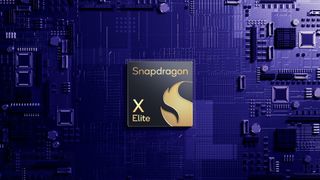
What you need to know
- Qualcomm has unveiled its first series of Snapdragon X platform for Windows laptops, dubbed Snapdragon X Elite.
- The new Oryon CPU powers the chip and packs 4.5x faster AI processing than competitors.
- Qualcomm claims that in single-threaded scores, the Elite X platform can beat Apple’s best M2 Max and Intel’s mighty Core i9-13980HX processors and match peak performance at 30% and 70% less power consumption, respectively.
- Windows laptops powered by Snapdragon Elite X and the Oryon CPU are due in mid-2024 from various OEMs.
After a few years of development from its Nuvia acquisitions, Qualcomm is finally pulling the curtain back on its next-gen processors and, at least going by Qualcomm’s claims, these are going to be some of the most powerful mobile processors on the planet while also being significantly more efficient.
The Qualcomm Oryon CPU powers the new Snapdragon X Elite platform on a 4nm node, which sports a 64-bit architecture, 12 cores up to 3.8GHz, and single and dual-core boost up to 4.3GHz. The accompanying Adreno GPU packs a punch and can handle up to 4.6 TFLOPs.
| Feature | Specification |
|---|---|
| CPU | Qualcomm Oryon CPU, 64-bit architecture, 12 cores up to 3.8 GHz, single and dual-core boost, up to 4.3 GHz |
| GPU | Qualcomm Adreno GPU up to 4.6 TFLOPs, supports DX12 |
| NPU | Qualcomm Hexagon NPU, 45 TOPs |
| Memory | LPDDR5x, 8533 MT/s transfer rate, up to 64GB, 136 GB/s bandwidth, 8 channels |
| Storage | SD v3.0, NVME over PCIe Gen 4, UFS 4.0 |
| Process | 4nm |
| Display | Qualcomm Adreno DPU, up to UHD 120Hz with HDR10 |
| Connectivity | Snapdragon X65 5G Modem up to 10 Gbps, up to Wi-Fi 7, with Bluetooth LE 5.4 |
| More features | AV1 encoding, decoding ffor 4K HDR video, lossless sound with Snapdragon Sound Tech Suite, on-device generative AI at 30 tokens per second, "enterprise grade" security |
By comparison, Microsoft’s Xbox Series S calculates just 4 teraflops (the Series X does 12.15).
Memory (RAM) gets up to LPDDR5x at 8533 MT/s up to 64GB, matching many of today’s top-tier laptops. NVMe SSD over PCIe Gen 4 is also supported for storage along with UFS 4.0.
Unsurprisingly, Snapdragon X Elite supports 4G TLE and 5G along with Bluetooth 5.4/LE, Wi-Fi 6, Wi-Fi 6E, and the latest Wi-Fi 7, giving it all the modern-day connectivity you can handle.
While Thunderbolt 4 or Thunderbolt 5 (an Intel technology) is not supported, there is the ability to leverage USB 4.0 (up to 3x) along with 2x USB 3.2 Gen 2 and 1x eUSB2. Thunderbolt 4 and USB4 are functionally equivalent, but the former has tighter minimum specs.
Qualcomm Snapdragon X Elite: Real-world comparisons
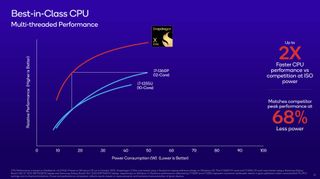
Of course, specs don’t tell the whole story, although what Qualcomm has listed so far is very impressive. Going deeper into what the Snapdragon X Elite compares to is extremely promising.
Get the Windows Central Newsletter
All the latest news, reviews, and guides for Windows and Xbox diehards.
During today’s Snapdragon Summit Keynote, CEO Cristiano Amon revealed some specific details about the X Elite’s performance, which is quoted as:
- It beats Apple’s M2 Max in single-threaded performance and matches competitor peak performance at 30% less power consumption.
- It beats Intel’s Core i9-13980Hx in single-threaded performance and matches competitor peak performance at 70% less power consumption.
In multi-core, Qualcomm claims it is 50% faster than Apple's M2 processor at peak performance.
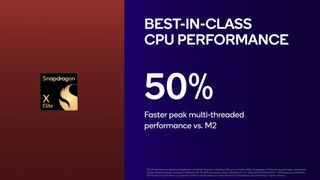
Indeed, in some graphs, which undeniably favor the story Qualcomm wants to tell, it claims its X Elite platform with Oryon CPU is 2x as fast as Intel’s Raptor Lake 13th Gen Core i7-1355U (10 core) and Core i7-1360P (12 core) processors while only using 1/3 of the power at peak performance.
Turning to the big guns, Qualcomm claims Oryon is even up to 60% faster than Intel’s 13th Gen Core i7-13800H (14 core) CPU, which is the type of processor found in workstations like the Dell XPS 15, while again only consuming 1/3 the power.
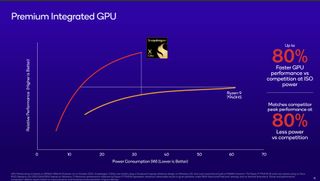
The same story holds for Snapdragon X Elite’s GPU, which is 2x faster than Intel Iris Xe found in the Core i7-13800H while using only ¼ the power draw and is 80% faster than AMD’s Ryzen 9 7940HS integrated GPU with 80% less power consumption.
Assuming Qualcomm’s numbers are remotely close to what is claimed, those are some astonishing benchmarks to be thrown around, especially compared to the older Snapdragon 8cX, which is closer to an Intel 11th Gen Core i5. Granted, Apple’s M3 series and Intel’s Meteor Lake chips are due in early 2024, negating some of the comparisons above. However, for a first-gen attempt, these numbers are a meaningful jump.
Qualcomm Snapdragon X Elite: AI, NPUs, and Sensing Hubs

Just as important is the neural processing unit (NPU) found in the Qualcomm Snapdragon X Elite platform, which is meant to usher in a new era of localized AI processing and will be a significant driver for what is expected to be Windows 12, due later in 2024.
Qualcomm claims its new Hexagon NPU hits up to 45 TOPs (Tera Operations Per Second) and can run generative AI LLM (large language models) over 13B parameters on-device with “blazing speeds.”
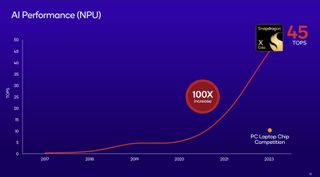
Some of the benefits of an NPU are the extreme speed and efficiency compared to using a CPU or GPU to calculate AI models. Additionally, since all processing is localized, it’s faster since data is not uploaded and redownloaded from the cloud, and it is also more secure for the same reason.
Perhaps more interesting is the addition of a second Micro NPU inside the “ultra-low power Qualcomm Sensing Hub,” which is a human presence detection system that can wake the PC when in sleep mode by noticing a person is in front of it (and lock when the person walks away). While Intel has had such abilities for a few years, Qualcomm claims its system is so efficient that it is always on.
Surface Pro 10? Faster than an XPS 15, more efficient than an iPad
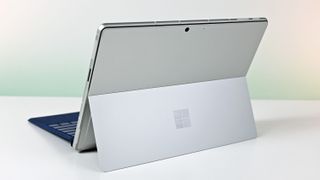
Although Microsoft did not announce a Surface Pro 10 at today’s Qualcomm keynote, there is no reason that the company could not release what could be the dream 2-in-1 PC. Assuming Qualcomm’s numbers and no restrictions for tighter thermal constraints, Microsoft’s prized tablet PC could be more potent than the current gen Dell XPS 15 workstation and get better battery life than the iPad Pro.
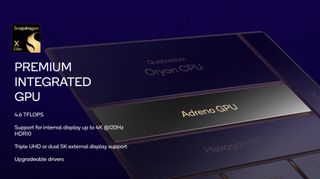
Such a combination would be a remarkably powerful PC that is not only extremely fast but also packs some of the highest level NPU performance known, all while getting significantly better battery life than the competition.
Microsoft is not expected to release a Surface Pro 10 until fall 2024, and by then, Apple and Intel will already have faster systems, but that won’t negate what could be the holy grail in Windows computing.
Qualcomm Snapdragon X: More than Elite?
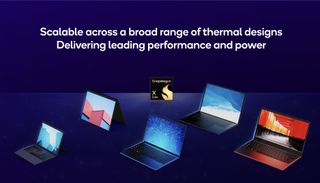
Qualcomm’s new platform, as revealed a few weeks ago, is Snapdragon X, with the new ‘Elite’ branding to signify we’re likely getting the top-tier version first (although Oryon can scale up, so a ‘Pro’ or ‘Max’ branding could also be in the works for desktop PCs.)
The takeaway is that the Elite series is just one of the multiple versions of this platform that Qualcomm is set to release over the coming years to hit different PC categories at different price points, possibly higher and very likely lower, to better compete against Intel and AMD.
Indeed, Qualcomm even remarked during the keynote that Oryon isn’t only for Windows laptops, as Oryon will be “making its way into smartphones, cars, XR devices, and more in the future.”
Qualcomm Snapdragon X Elite: What about emulation?

Although Qualcomm did work closely with Microsoft to ensure the Snapdragon X Elite platform is optimized for Windows 11 (and presumably the next refresh), there is no new news on any technology for translating x86 apps to ARM64.
The good news is it may not even be an issue any longer. While x86 apps always run on ARM in Windows, the previous complaint was the degradation in performance. You’re taking an older Core i5 and slowing it down to something worse.
With Oryon performing better than a Core i7 H-series processor (45W) and even HX series (55W) at 1/3 the power, any slowdown in performance is still likely to result in just-as-fast speeds as any current 13th Gen Intel Core P-series chip for standard Windows apps.
Of course, benchmarks need to be done, but with so much performance running, something like Google Chrome should “feel” just fine.
Qualcomm Snapdragon X Elite: When?

Qualcomm states that new PCs built on its X Elite platform will be available to consumers starting mid-2024. While that is a long lead time of roughly eight months, that aligns with previous Qualcomm CPU releases following announcements at its Snapdragon Summit.
Quite a few PC vendors are expected to release new hardware with the platform and new processors, including 2-in-1s, larger 15-inch laptops (which can support large batteries), traditional thin-and-light laptops, and maybe even PCs with displays that fold.
We’ll likely see early previews of that new hardware at the Consumer Electronics Show (CES) in early January 2024.
Update 4 PM ET: Lenovo and HP's respective CEOs endorsed Qualcomm's new Windows platform, suggesting there's a good chance we'll see new X Elite PCs from both later in 2024. Microsoft was also on stage to boast about Windows and hardware.
Qualcomm Snapdragon X Elite: More to come
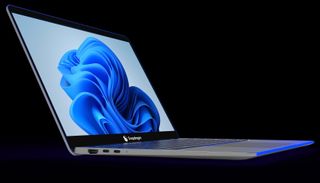
Qualcomm is set to open the floor up later this afternoon to press to likely see reference designs (laptops built by Qualcomm to demonstrate the Snapdragon X Elite), go deeper into CPU benchmarks, platform specifications, and answer questions from the press.
It’s unclear if other Windows OEMs will be present with their hardware, but stay tuned to Windows Central, as we’ll have all the coverage and some interviews coming over the next few days.

Daniel Rubino is the Editor-in-chief of Windows Central. He is also the head reviewer, podcast co-host, and analyst. He has been covering Microsoft since 2007, when this site was called WMExperts (and later Windows Phone Central). His interests include Windows, laptops, next-gen computing, and watches. He has been reviewing laptops since 2015 and is particularly fond of 2-in-1 convertibles, ARM processors, new form factors, and thin-and-light PCs. Before all this tech stuff, he worked on a Ph.D. in linguistics, watched people sleep (for medical purposes!), and ran the projectors at movie theaters because it was fun.
-
Ben Wilson "Qualcomm Adreno GPU up to 4.6 TFLOPs, supports DX12."Reply
The Steam Deck GPU has 1.6 TFLOPS, so maybe Valve's handheld follow-up isn't THAT far away.. they say nothing will happen until Steam Deck 2 can make a 'significant leap.' That's pretty significant. -
ShinyProton Considering how good the 8cx Gen 3 is at running Windows 11, I'm really excited by the new Snapdragon X Elite. The performance/power ratio is going to be impressive.Reply
Let's hope the pricing is right and that companies like Robo&Kala jump in to offer outstandingly well-priced devices - (exactly the opposite Microsoft did with the Surface 9 Pro SQ3). -
GraniteStateColin Reply
For MS pricing, keep in mind that they intentionally price high to protect their OEMs -- they are trying not to compete with them on price, lest they hurt their main partners. At least, that was the original strategy.ShinyProton said:Considering how good the 8cx Gen 3 is at running Windows 11, I'm really excited by the new Snapdragon X Elite. The performance/power ratio is going to be impressive.
Let's hope the pricing is right and that companies like Robo&Kala jump in to offer outstandingly well-priced devices - (exactly the opposite Microsoft did with the Surface 9 Pro SQ3).
On the other hand, if Surface's role as innovator and design leader left with Panos, then maybe they'll target price competition going forward, but I hope not. If you want a cost effective design, go with HP, Dell, Lenovo, Samsung, Acer, Asus or one of the others. Surface models should continue to provide novel form factors and inspire the OEM's. -
fjtorres5591 Reply
There are rumors that the next Nintendo console will be comparable to the PS4 Pro: 4TF. That fits.Ben Wilson said:"Qualcomm Adreno GPU up to 4.6 TFLOPs, supports DX12."
The Steam Deck GPU has 1.6 TFLOPS, so maybe Valve's handheld follow-up isn't THAT far away.. they say nothing will happen until Steam Deck 2 can make a 'significant leap.' That's pretty significant.
The Steam Deck is more likely to go with an AMD Ryzen Z1 variant APU since Steam's business is X86. -
Daniel Rubino Reply
Yeah, I agree with that. AMD is likely to be their partner from now on, likely working hand-in-hand with Valve for some customization.fjtorres5591 said:There are rumors that the next Nintendo console will be comparable to the PS4 Pro: 4TF. That fits.
The Steam Deck is more likely to go with an AMD Ryzen Z1 variant APU since Steam's business is X86. -
wojtek would be awesome. currently having first mbp with m1 and I just love the device - it's completely silent, doesn't heat up and last on the battery very long time <3Reply -
Jez Corden Maybe the rumors of Xbox partnering with Qualcomm for the next Xbox aren't so far fetched either. o_OReply -
ShavedMonkey Daniel, please fact check.Reply
Single-threaded performance had not been mentioned or presented by Qualcomm. All your articles keep on mentioning it.and making claims.
Ars, Anand all make clear mention of this.
Whilst very exciting news, this is a very important consideration missed - also a missed opportunity with the Qualcomm interview.
Happy to be corrected. -
End User Qualcomm makes no mention of ARM regarding the Snapdragon X Elite in any product info I have read. This is not surprising because Qualcomm does not yet have an ARM license for the Snapdragon X Elite. How can Windows 11/12 for ARM legally run on an unlicensed SoC? ARM is currently suing Qualcomm over the lack of an ARM license for the X Elite. The X Elite is DOA unless Qualcomm gets an ARM license for it.Reply